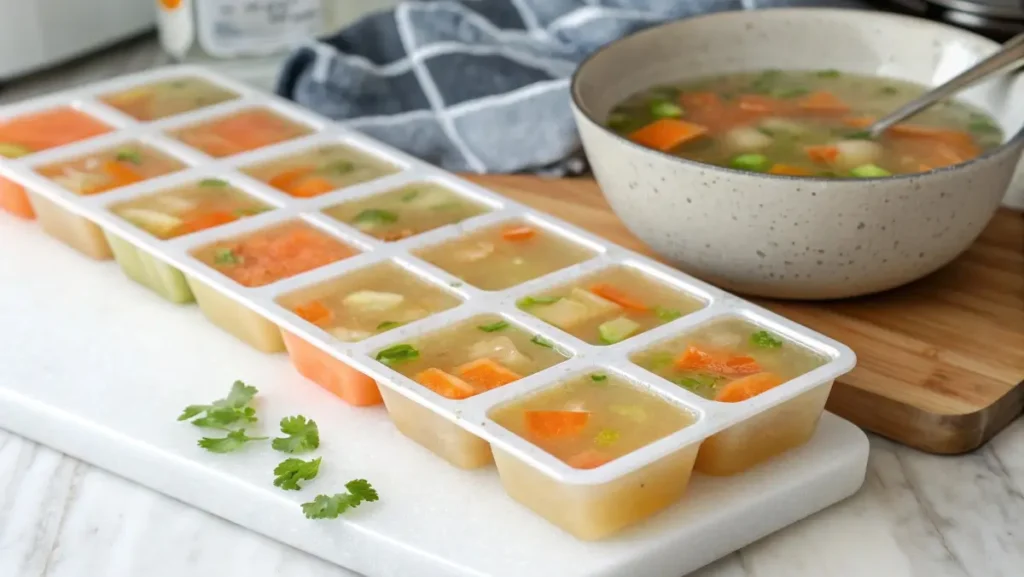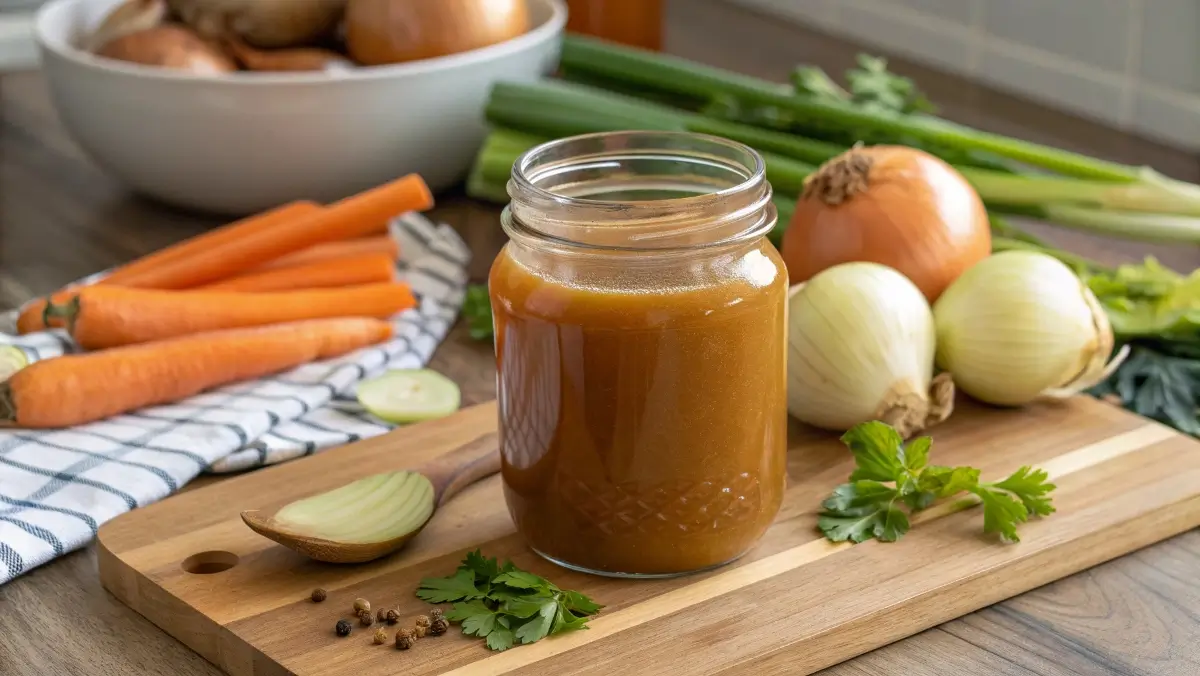Mirepoix Broth Concentrate: The Ultimate Guide to Flavor-Packed Cooking
Cooking is all about building layers of flavor, and few ingredients do this as effortlessly as mirepoix broth concentrate. This flavor-packed base, rooted in French culinary tradition, combines the aromatic magic of onions, carrots, and celery into a concentrated form that transforms soups, stews, sauces, and more.
Whether you’re aiming for a comforting winter soup or a rich pasta sauce, mirepoix broth concentrate adds that “something special” you can taste but can’t quite put your finger on.
If you’re new to this savory powerhouse, you’ll learn exactly what it is, how it’s made, the best ways to use it, and even how to make your own at home. We’ll also explore healthy variations, storage tips, and smart substitutions. And if you’re craving more veggie-based soup inspiration, discover great ideas like our 10-vegetable soup recipe.
Table of Contents
Understanding Mirepoix Broth Concentrate
What is Mirepoix Broth Concentrate?
Mirepoix broth concentrate is a condensed cooking base made from the classic mirepoix blend—finely chopped onions, carrots, and celery—slowly simmered until their flavors meld into a rich, aromatic liquid. That liquid is then reduced to create a thick, intensely flavored paste or gel. Because it’s concentrated, just a spoonful can infuse dishes with a deep, savory taste that would otherwise require hours of simmering. Unlike plain vegetable broth, mirepoix broth concentrate delivers a layered, aromatic punch right from the jar.
The Origin of Mirepoix in French Cuisine
The word mirepoix (pronounced “meer-pwah”) comes from 18th-century France, named after the Duc de Mirepoix, whose chef is credited with popularizing this aromatic vegetable base. Traditionally, mirepoix is used as the first step in countless French soups, braises, and sauces. Over time, cooks around the world adapted the technique, creating modern versions like broth concentrates and bouillon pastes. In today’s kitchens, mirepoix broth concentrate blends Old World tradition with modern convenience—allowing home cooks to recreate rich, slow-cooked flavors in minutes.
Ingredients & Flavor Profile
Core Components of Mirepoix Broth Concentrate
At its heart, mirepoix broth concentrate is built on the traditional 2:1:1 ratio of onions, carrots, and celery. This classic trio is finely chopped, slowly cooked to release natural sugars, and then simmered to deepen its flavor. Many commercial versions also include:
- Garlic – to boost aromatic intensity
- Herbs – such as thyme, parsley, or bay leaf for complexity
- Salt & Seasonings – to balance and enhance flavors
- Olive oil or butter – for a rich mouthfeel
- Umami enhancers – like tomato paste or mushroom powder

Some brands add roasted vegetables or leeks to create a slightly sweeter, more layered taste. When choosing or making your own, focus on natural ingredients without artificial preservatives for the best flavor and health benefits.
How the Vegetable Blend Creates Depth of Flavor
The magic of mirepoix lies in its balance:
- Onions bring sweetness and a mellow, earthy aroma.
- Carrots add subtle sweetness and color.
- Celery contributes a fresh, slightly peppery undertone.
When cooked together, these flavors merge into a savory, almost meaty richness—without any meat at all. The slow cooking process caramelizes sugars in the vegetables, while simmering extracts water-soluble flavor compounds. This results in a broth concentrate that feels both comforting and complex.
Whether you’re stirring it into soup or adding a spoonful to rice, this blend works like a flavor “cheat code.” Don’t miss our gluten-free chicken noodle soup for a perfect example of how mirepoix broth concentrate can elevate a classic recipe.
How to Use Mirepoix Broth Concentrate in Cooking
Diluting & Mixing for Soups and Stews
One of the simplest ways to use mirepoix broth concentrate is to dilute it with hot water to create an instant broth. The general rule is 1 teaspoon of concentrate per 1 cup of water, but you can adjust based on how intense you want the flavor. This quick method works beautifully for:
- Soups – from classic vegetable to hearty lentil
- Stews – to add complexity without long simmer times
- Braises – as a cooking liquid for tender meats and vegetables
Because it’s concentrated, a little goes a long way. Start with less and taste as you go—you can always add more, but you can’t take it out once it’s too strong.
Creative Uses in Rice, Pasta, and Sauces
Mirepoix broth concentrate isn’t just for soups. Try these flavorful twists:
- Rice & Grains – Stir into the cooking water for a subtle savory boost.
- Pasta Dishes – Add a teaspoon to the sauce to give it a slow-cooked flavor in minutes.
- Gravy & Pan Sauces – Use it as a base instead of plain broth for richer results.
- Vegetable Sauté – Dissolve in a splash of water to glaze veggies after cooking.
For inspiration, don’t miss our garlic parmesan chicken pasta, where a touch of mirepoix broth concentrate in the sauce deepens the flavor without overpowering it.
Substitutes for Mirepoix Broth Concentrate
Best Homemade Alternatives
If you’re out of mirepoix broth concentrate but still want that same depth of flavor, you can easily whip up a substitute with ingredients you probably already have:
- Fresh Mirepoix – Sauté equal parts onions, carrots, and celery in butter or oil until soft, then blend with a bit of water or stock to create a quick paste.
- Vegetable Stock with Extra Mirepoix – Start with a standard veggie broth, then simmer it for 20–30 minutes with extra onions, carrots, and celery for a stronger base.
- Mirepoix Seasoning Blend – Use dried vegetable flakes or a freeze-dried mirepoix mix rehydrated in hot water.
Making it fresh at home allows you to control the salt level and adjust the flavor intensity to suit your recipe.
Store-Bought Substitutes & Flavor Adjustments
If homemade isn’t an option, look for these pantry-friendly alternatives:
- Vegetable Bouillon Paste – Similar consistency but may be saltier, so adjust seasoning.
- Broth Concentrate Packets – Often labeled as “vegetable base” or “savory broth.”
- Onion Soup Base – Provides a similar aromatic foundation but with a stronger onion profile.
When using substitutes, consider adding herbs like thyme or parsley to mimic mirepoix’s herbal notes. For an easy protein pairing, check out our healthy shredded chicken, which works wonderfully with a vegetable-forward broth base.
Mirepoix Broth vs. Other Broths
Mirepoix Broth vs. Vegetable Broth
While both are plant-based and aromatic, mirepoix broth concentrate is more than just vegetable broth. Vegetable broth typically includes a mix of various vegetables, herbs, and sometimes tomato for acidity. Mirepoix broth, however, focuses on the classic trio of onions, carrots, and celery in a precise ratio, delivering a balanced, slightly sweet, and earthy flavor profile. Because mirepoix is reduced into a concentrate, it’s also far more intense—meaning you need less to achieve bold flavor.
Broth Concentrate vs. Bouillon
Bouillon is typically dehydrated broth—either in cube or powder form—with added salt, preservatives, and sometimes MSG. Broth concentrate, on the other hand, is a thick paste or gel that retains more of the original vegetables’ natural flavor compounds. Mirepoix broth concentrate in particular contains minimal processing, allowing it to preserve the aroma and sweetness of fresh vegetables.
If you prefer cooking with whole-food ingredients and avoiding excessive sodium, mirepoix broth concentrate often wins in both taste and nutrition. For a recipe where this distinction really shines, don’t miss our Gluten-Free Chicken Noodle Soup, which showcases the vibrant character of a mirepoix base.
Health Benefits and Nutritional Value

Nutrient Profile of Mirepoix Broth Concentrate
Because mirepoix broth concentrate is made primarily from vegetables, it retains many of their natural nutrients, though the amounts vary depending on cooking and concentration methods. Key nutrients often include:
- Vitamin A from carrots, which supports eye health
- Vitamin C from celery and onions, aiding immunity
- Antioxidants like flavonoids from onions, which combat inflammation
- Minerals such as potassium and magnesium for heart health
Some store-bought versions may also be fortified with additional vitamins or reduced sodium for specific dietary needs.
Low-Calorie, High-Flavor Option for Healthy Cooking
One of the biggest advantages of mirepoix broth concentrate is that it delivers deep, satisfying flavor without adding significant calories or fat. A teaspoon typically contains fewer than 10 calories, making it a smart choice for:
- Weight management recipes where flavor is key but calories are limited
- Low-sodium diets, when you choose unsalted or reduced-salt versions
- Vegetarian and vegan diets, as it adds savory depth without animal products
Pair it with nutrient-rich dishes like our Panera Chicken Tortilla Soup for a meal that’s both wholesome and satisfying.
How to Make Mirepoix Broth Concentrate at Home
Step-by-Step Recipe
Making mirepoix broth concentrate at home is straightforward, and the results are often fresher and more vibrant than store-bought.
Ingredients:
- 4 cups chopped onions
- 2 cups chopped carrots
- 2 cups chopped celery
- 3 tbsp olive oil or unsalted butter
- 2 tsp salt (optional)
- 1 tsp dried thyme (or 2 tsp fresh)
- 2 bay leaves
- 6 cups water
Instructions:
- Sauté Vegetables – Heat oil in a large pot. Add onions, carrots, and celery. Cook over medium heat for 15–20 minutes, stirring occasionally, until vegetables are soft and starting to caramelize.
- Add Seasonings – Stir in thyme, bay leaves, and salt (if using).
- Simmer – Pour in water and bring to a boil. Reduce heat and simmer for 45 minutes to 1 hour.
- Blend & Reduce – Remove bay leaves. Blend the mixture until smooth, then return to the pot and simmer uncovered until thickened into a paste-like concentrate.
- Cool & Store – Let cool completely before transferring to airtight jars or freezer-safe containers.

Storage Tips for Longer Shelf Life
- Refrigeration – Store in an airtight container for up to 2 weeks.
- Freezing – Freeze in ice cube trays, then transfer cubes to a freezer bag for up to 6 months.
- Vacuum Sealing – For the longest storage, vacuum seal portions and freeze.
Making succotash at home lets you control the salt, use fresh organic produce, and customize the herbs for your own signature flavor.
Storing and Preserving Mirepoix Broth Concentrate
Refrigeration and Freezing Methods
Once you’ve prepared or opened mirepoix broth concentrate, proper storage is the key to preserving both flavor and safety.
- Refrigeration – Store in an airtight container in the refrigerator, where it will stay fresh for up to 2 weeks. Always use a clean spoon to scoop it out to avoid contamination.
- Freezing – For longer storage, freeze in small portions. Ice cube trays work perfectly—each cube equals about 1 tablespoon. Transfer the frozen cubes to a freezer-safe bag and use them as needed for up to 6 months.
- Vacuum-Sealed Freezer Bags – For bulk batches, vacuum sealing prevents freezer burn and helps maintain freshness even beyond 6 months.
Signs of Spoilage and Food Safety
To ensure safe use, check for these signs before cooking with your concentrate:
- Off Smell – A sour or fermented odor indicates spoilage.
- Texture Change – Mold growth or slimy consistency means it’s time to discard.
- Color Shift – Darkening beyond the usual rich brown may suggest it’s past its prime.
Always err on the side of caution—when in doubt, throw it out. Using spoiled concentrate not only ruins your dish but can also cause foodborne illness.
Conclusion: Why Mirepoix Broth Concentrate Belongs in Every Kitchen
Mirepoix broth concentrate is more than just a shortcut—it’s a flavor enhancer that saves time without sacrificing depth. From soups and stews to grains, sauces, and even glazes, this versatile paste transforms everyday meals into something richer and more comforting. Whether you buy it ready-made or prepare it at home, it’s a pantry essential that delivers both taste and nutrition.
Looking for inspiration? Try our Instant Pot Vegetable Beef Soup for a hearty recipe where mirepoix broth concentrate shines.
FAQs
What is mirepoix broth concentrate?
Mirepoix broth concentrate is a reduced, flavor-packed paste made from the classic French trio of onions, carrots, and celery. It delivers the depth of a slow-simmered broth in a convenient, ready-to-use form.
What is a substitute for mirepoix broth?
The best substitute is a homemade mix of sautéed onions, carrots, and celery blended with a little water or broth. Vegetable bouillon paste or broth concentrate packets also work in a pinch.
Is mirepoix broth the same as vegetable broth?
Not exactly. Vegetable broth contains a wide range of vegetables and herbs, while mirepoix broth is based specifically on the onion-carrot-celery blend in a concentrated form, giving it a more balanced and layered taste.
Is bouillon the same as broth concentrate?
No. Bouillon is usually dehydrated broth shaped into cubes or granules with added salt and preservatives. Broth concentrate is a thick paste that preserves more of the original vegetable flavors.
What is broth concentrate?
Broth concentrate is a reduced, condensed version of broth that has been cooked down until it becomes a flavorful paste or gel. It’s stronger than regular broth and requires dilution.
Is bone broth concentrate just as good as bone broth?
Bone broth concentrate is nutritionally similar to bone broth, as it’s simply reduced for convenience. However, its quality depends on the ingredients used. For clean flavor, always choose bone broth concentrates without unnecessary additives.

